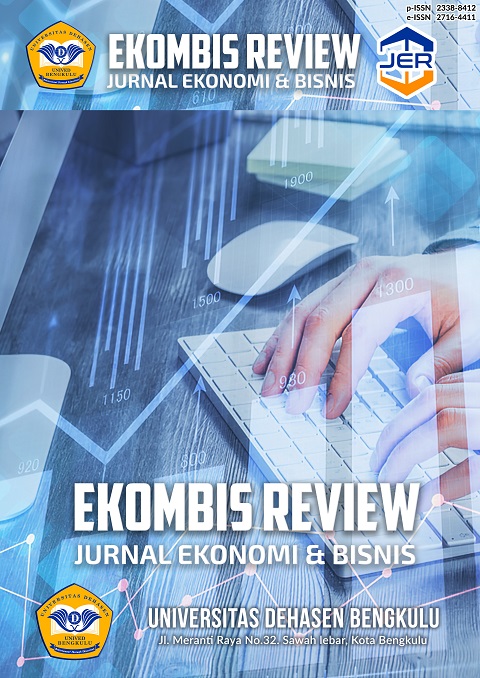Pengaruh Fraud Diamond Terhadap Financial Statement Fraud (Studi Terhadap Perusahaan Anggota Indeks Sri-Kehati Yang Terdaftar Di Bursa Efek Indonesia Tahun 2016-2020)
Abstract
Financial statement is the document containing information that describes the company's financial condition and reflects the actual state of the company. Thus, it makes the management trying to produce financial statements describing that the company is in a healthy condition. However, management performance is sometimes not as good as expected. This encourages management to commit fraudulent financial statements. This study aims to determine the effect of the fraud diamond variables, namely pressure, opportunity, rationalization, and capability on financial statement fraud in SRI-KEHATI index member companies listed on the Indonesia Stock Exchange in 2016-2020. The sample selection technique used purposive sampling technique in order to obtain a sample of 70 companies. The data analysis technique used is descriptive statistical analysis and panel data regression using Eviews 12 software. The results of the study showed that the variables of pressure, opportunity, rationalization, and capability simultaneously had an influence on the financial statement fraud. The results of the study partially showed that the variables of financial stability, financial target, external pressure had a positive influence on the financial statement fraud. Meanwhile, the nature of industry had a negative influence on the financial statement fraud. Ineffective monitoring, change in auditor, and change in director variables had no influence on financial statement fraud.
Downloads
References
Adnovaldi, Y., & Wibowo, W. (2019). Analisis Determinan Fraud Diamond Terhadap Deteksi Fraudulent Financial Statement. Jurnal Informasi, Perpajakan, Akuntansi, Dan Keuangan Publik, 14(2), 125–146. https://doi.org/10.25105/jipak.v14i2.5195
Akbar, T. (2017). the Determination of Fraudulent Financial Reporting Causes By Using Pentagon Theory on Manufacturing Companies in Indonesia. International Journal of Business, Economics and Law, 14(5), 106–112.
Alfina, D. F., & Amrizal, A. (2020). Pengaruh Faktor Tekanan, Peluang, Rasionalisasi, Kompetensi, dan Arogansi Terhadap Kecurangan Laporan Keuangan. Akuntabilitas, 13(1), 63–76. https://doi.org/10.15408/akt.v13i1.14497
Annisya, M., Lindrianasari, & Asmaranti, Y. (2016). Pendeteksian Kecurangan Laporan Keuangan Menggunakan Fraud Diamond. Jurnal Bisnis Dan Ekonomi (JBE), 23(1), 72–89. https://media.neliti.com/media/publications/76514-ID-pendeteksian-kecurang-laporan-keuangan-m.pdf
Dumaria, N. (2019). THE EFFECT OF FRAUD PENTAGON IN DETECT FRAUDULENT FINANCIAL REPORTING USING BENEISH M-SCORE MODEL (Empirical Study on Mining Companies Listed in the Indonesia Stock Exchange in 2014-2017). 6(2), 3148–3156.
Handayani, R., Sutarjo, A., & Yani, M. (2021). Pengaruh Pressure , Opportunity dan Rationalization (Fraud Triangle) terhadap Financial Statement Fraud ( Studi Empiris Pada Perusahaan Manufaktur yang Terdaftar di Bursa Efek Indonesia Tahun 2013-2017). Pareso Jurnal, 3(3), 683–694.
Hery. (2016). Analisis Laporan Keuangan Integrated and Comprehensive Edition. Grasindo.
Jao, R., Mardiana, A., Holly, A., & Chandra, E. (2020). Pengaruh Financial Target dan Financial Stability terhadap Financial Statement Fraud. Journal of Management, 4(1), 27–42. https://doi.org/10.37531/yum.v11.76
Jensen, M. C., & Meckling, W. H. (1976). THEORY OF THE FIRM: MANAGERIAL BEHAVIOUR, AGENCY COSTS AND OWNERSHIP STRUCTURE. Journal Of Financial Econimics, 3. https://doi.org/10.1177/0018726718812602
Nugraheni, N. K., & Triatmoko, H. (2018). Analisis Faktor-Faktor yang Mempengaruhi Terjadinya Financial Statement Fraud: Perspektif Diamond Fraud Theory (Studi Pada Perusahaan Perbankan yang Terdaftar Di Bursa Efek Indonesia Periode 2014-2016). http://etd.lib.metu.edu.tr/upload/12620012/index.pdf
Pribadi, A., & Nuryatno, M. (2019). Pengaruh Pressure, Opportunity, Rationalization dan Capability terhadap Financial Statement Fraud. Inovasi, 15(2), 120–127.
Puspitha, M. Y., & Yasa, G. W. (2018). Fraud Pentagon Analysis in Detecting Fraudulent Financial Reporting. International Journal of Sciences: Basic and Applied Research, 42(5), 93–109. http://gssrr.org/index.php?journal=JournalOfBasicAndApplied
Rahmayuni, S. (2018). Analisis Pengaruh Fraud Diamond Terhadap Kecurangan Laporan Keuangan (Studi Empiris Pada Perusahaan Manufaktur yang Terdaftar di BEI Tahun 2013-2016). Journal Akuntansi Universitas Negeri Padang, 6, 1–20.
Siddiq, R. F., Achyani, F., & Zulfikar. (2017). Fraud Pentagon Dalam Mendeteksi Financial Statement Fraud. Seminar Nasional Dan the 4Th Call Syariah Paper, ISSN 2460-0784, 1–14. http://hdl.handle.net/11617/9210
Skousen, C. J., Smith, K. R., & Wright, C. J. (2009). Detecting and predicting financial statement fraud: The effectiveness of the fraud triangle and SAS No. 99. Advances in Financial Economics, 13(99), 53–81. https://doi.org/10.1108/S1569-3732(2009)0000013005
Suatkab, N., & Nurbaiti, A. (2017). ANALISIS FRAUD DIAMOND DALAM MENDETEKSI FRAUDULENT FINANCIAL STATEMENT (Studi Empiris pada Perusahaan Properti, Real Estate, dan Konstruksi Bangunan yang Terdaftar di Bursa Efek Indonesia Tahun 2013-2017). Telkom University.
Sugiyono. (2018). Metode Penelitian Kuantitatif, Kualitatif, R&D. Bandung. ALFABETA.
Wilestari, M., & Fujiana, N. (2021). Analisis pengaruh Diamond Fraud terhadap Financial Statement Fraudulent. AKRUAL : Jurnal Akuntansi Dan Keuangan, 3(Vol 3 No 1 (2021): AKRUAL : Jurnal Akuntansi dan Keuangan), 1–14. https://uia.e-journal.id/Akrual/article/view/1528
Yesiariani, M., & Rahayu, I. (2017). Deteksi financial statement fraud: Pengujian dengan fraud diamond. Jurnal Akuntansi & Auditing Indonesia, 21(1), 49–60. https://doi.org/10.20885/jaai.vol21.iss1.art5
Copyright (c) 2022 Salmaa Ummu Kultsum, Dedik Nur Triyatno

This work is licensed under a Creative Commons Attribution-ShareAlike 4.0 International License.
An author who publishes in the EKOMBIS REVIEW: Jurnal Ilmiah Ekonomi dan Bisnis agrees to the following terms:
Author retains the copyright and grants the journal the right of first publication of the work simultaneously licensed under the Creative Commons Attribution-ShareAlike 4.0 License that allows others to share the work with an acknowledgement of the work's authorship and initial publication in this journal
Submission of a manuscript implies that the submitted work has not been published before (except as part of a thesis or report, or abstract); that it is not under consideration for publication elsewhere; that its publication has been approved by all co-authors. If and when the manuscript is accepted for publication, the author(s) still hold the copyright and retain publishing rights without restrictions. For the new invention, authors are suggested to manage its patent before published. The license type is CC-BY-SA 4.0.
EKOMBIS REVIEW: Jurnal Ilmiah Ekonomi dan Bisnis is licensed under a Creative Commons Attribution-ShareAlike 4.0 International License.














